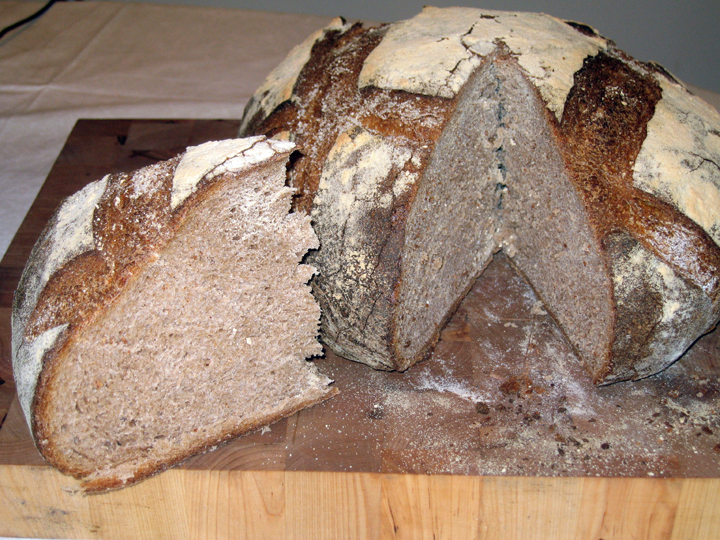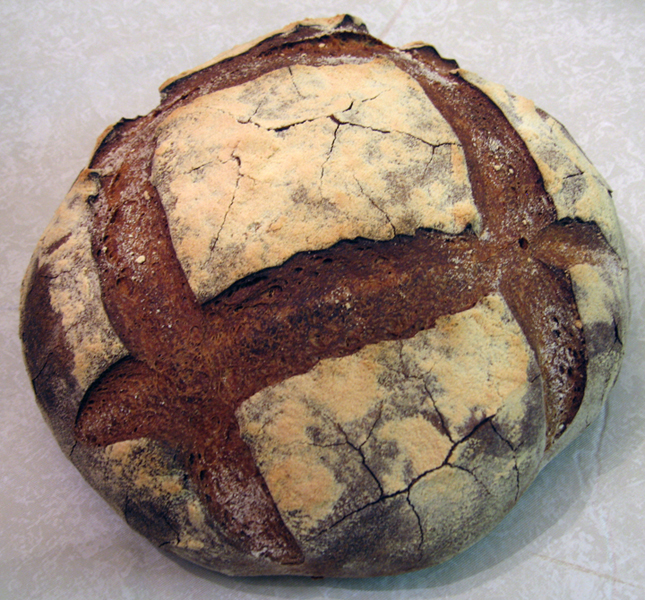
Chasing Poilâne

Here is one of many loafs I have made following Peter Reinhart's instructions for the Poilâine-Style Miche in his book Bread Baker's Apprentice. I really just wanted to make this blog entry to share some of my pictures of this loaf. I have been making a Poilâine loaf every weekend for the past couple of months and I continue to tweak everything, especially the flour types/brands, blends, and siftings. Depending on these factors, especially the flour, the hydration also gets tweaked. I love making these loafs and I have never made one that wasn't delicious and eaten within a week but I continue to chase Poilâine nirvana. As we all know, as for the real Poilâne loaf, the key is in the proprietary French T80 flour he uses. This odd gray flour, most likely, can't be replicated BUT it is possible to make a loaf at home that is as good, if not better than his loaf!

In this loaf's rendition I used 100% Bob's Red Mill Whole Wheat Flour which I double sifted to remove some of the bran. This flour is stone ground from hard red U.S. dark northern spring wheat and has all of the bran and germ still intact. This flour is an over the counter flour in my area and the grind is somewhat finer than the local organic, freshly ground, whole wheat flour that I have been recently using...that is a whole other blog entry. So, it is not as easy to remove this finer bran. If I used this flour again I would sift it some more to try to remove a little more of the bran.
I love how this loaf came out. The loaf sang like a woodpecker when it came out of the oven creating a beautiful crackly crust as it cooled. The aroma was amazing, a rich caramelized wheaty aroma that reminded me of a bowl of hot grape-nuts cereal...I know, I'm crazy. The crumb was tight, yet light, moist, and springy. I was pleasantly surprised by the awesome flavor, the crumb had a distinctive wheaty and lightly sour taste and the crust had a deep caramel flavor with a fantastically sour bite. After I cut into it I kept it in a brown paper bag and it stayed fresh, except for the drying of the exposed cutting areas, and totally edible for an entire week.
I currently have daily access to actual Poilâine loafs here in New York City from Agata & Valentina so I am aware of what it looks and tastse like and this loaf is quite different, haha.

Enjoy the pictures,
Nick


Comments
Wow! That's a beauty...
Thanks man! You make some killer looking breads yourself, your latest baguettes looked awesome. Where do you play in NYC I wouldn't mind seeing some rockin bass playing?
Nick
I don't play out anymore. My band went kaput earlier this year. We are finishing up a full length CD and releasing it in the next few months... Then I'll have to look for a new band or something... Do you play anything?
I play a little piano but I love live entertainmnet. Keep me informed.
Nick
That's a beautiful miche with a great looking crust. What baking, temperature, time ect. did you choose! Wish I could have a taste : ) Thanks for sharing.
Sylvia
Thanks Sylvia,
I preheated the oven to 500°F, transferred the loaf onto the baking stone, poured 2 cups of boiling water into the steam pan, and lower the oven to 450° F.
I baked for 25 minutes, rotated the loaf 180 degrees, and baked for another 30 minutes.
My oven temp seems to like to drift higher so I watch my oven thermometer and if it tries to go above 450° F during baking I turn it down more.
Hope that answers your question,
Nick
That's a bold looking bread Nick. Nice job.
Eric
I guess bold is what I am going for, haha.
PS I really like how your Chocolate Sourdough breads came out in December. They looked quite awesome.
Nick
Nice job!! Boboshempy,
BTW, you could increase the hydration on this one, work the dough by means of french fold to develop as much gluten as possible, and then fermentation with stretches and folds in the bowl in the interim. I believe doing this will result in a much more open crumb for this whole wheat.
Just my 2 cents though
Nice work!
Thanks for the tips! I agree with you, this iteration is lacking a more open crumb. This was the one and only time I used this flour and it could have used slightly more hydration and possibly additional kneading. I would probably do both if I used this flour again to try to chase a more open crumb.
It is crazy how different flours absorb different amounts of water. This flour is on the high end. I used the most amount of water recommended and it could have used more hydration. I have made this with other flour blends where the dough has been very slack with much less water. This is where you need to be careful because it is very easy to make a 4.5lb pancake, haha.
Nick
Hi, Boboshempy
soaking half of the formula overnight will develop gluten, and when final dough is ready: Soaker+Biga/Poolish/preferment you will surely get a feel how the final outcome is ought to be, at which point you have to make the final adjustments of Water or Flour.
You would really recommend soaking half over night? I have never done that before. Do you think that is necessary or do you think a 1 hour autolysis would do the trick? What would be the difference between the two methods in a bread like this?
Thanks again,
Nick
Soaking the (non fermented) half of the dough overnight or upto 24hrs, and in room temperature will not only mimic the effect of 20 minutes kneading, but will also give a chance for the inherent enzymes (plenty in a wholwheat) to break the starch into simpler surgars, consequently giving the yeasts later on a better access to more readily absorbed food, hence better fermentation,and oven spring.